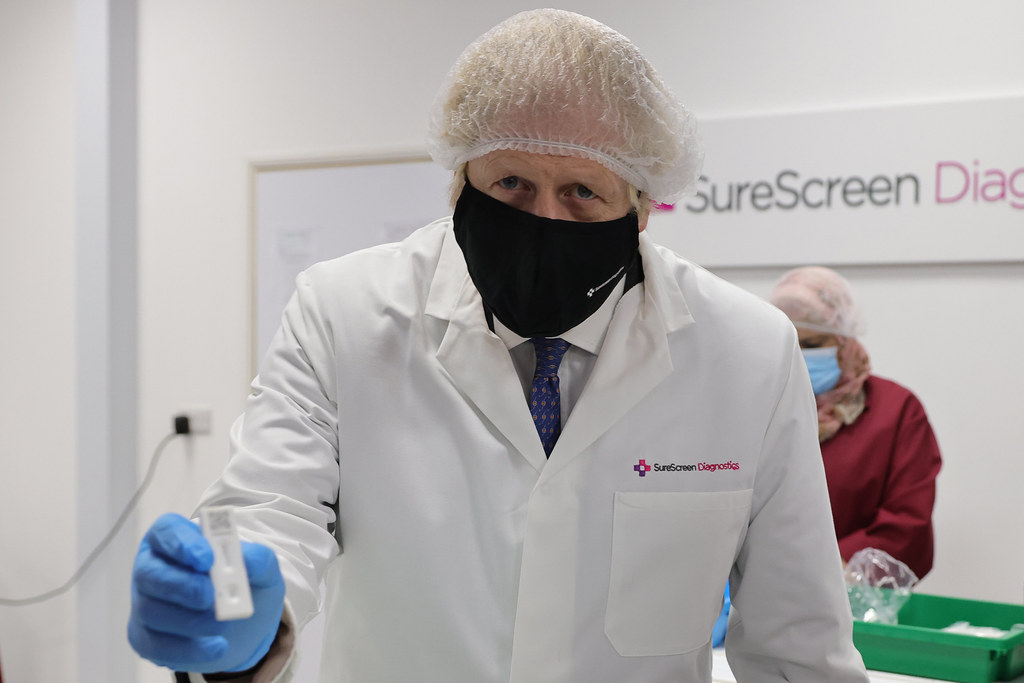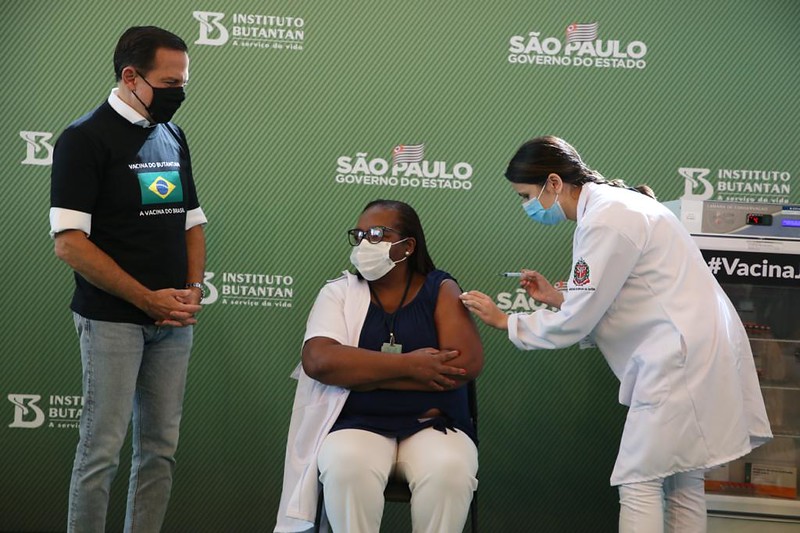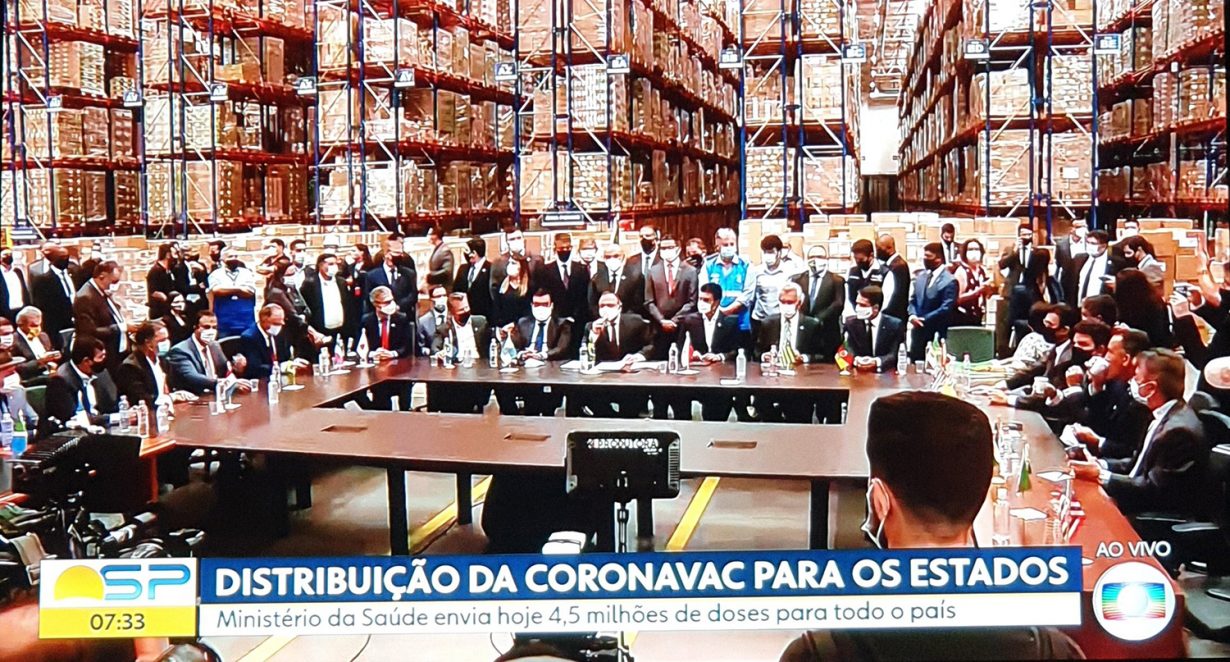One problem throughout the pandemic has been its own invisibility – enter the vaccination portrait: ‘cure as political metaphor’
Last month saw a plethora of photocalls to launch the rollout of various vaccines for COVID-19, opening up a new aesthetic front in the war against the pandemic. Globally these have been one of the few occasions over the past year in which embattled politicians have had the chance to disseminate a positive image of themselves. Most have milked it for all its worth. In the UK, the first man to receive a shot of the Pfizer-BioNTech jab was improbably named William Shakespeare. One can only presume this was meant to fly the flag of an otherwise much diminished Brand Britain (the first British woman, and first person to receive the vaccine in the world outside of clinical trials, was called Margaret Keenan – evidently UK government aides were unable to find anyone suitably named, say, Vera Lynn or Mr Bean).
One problem throughout the crisis has been its invisibility: the infinitesimal virus itself of course, but so too the deaths. There are no bomb sites or architectural ravages of war to be used as visual metaphors; just lonely final gasps for breath in isolation. The magnitude of the problem appears to only be comprehended rarely, when, for example, the mass graves in Hart Island, New York were caught on drone footage or a film crew managed to sneak into a grossly overloaded Mexican morgue. In Martha Rosler’s iconic series House Beautiful: Bringing the War Home (1967–72), for which images of the Vietnam War were collaged together with material from home-décor magazines, the artist sought to confront America with the horror it was instigating on the other side of the world. With the pandemic, the deaths, when they occurred, would happen shuttered away behind curtains, tragic but without spectacle. The spiralling case numbers were frightening but abstract; the daily briefings by chief scientists and politicians possess the ‘shy, evasive, glassy-eyed manner of speech’ that Kafka complained people would address tuberculosis with.

Commenting on his series of works featuring the pixelated mutilated bodies of war dead, the artist Thomas Hirschhorn noted ‘abstraction as thinking’ is ‘political thinking’: his 2016 Pixel-Collage series compared the crisp iconic image of US President Obama in the White House’s Situation Room with the blurred-out photographs of the dead on the ground. Our refusal, or inability, to look plays into powerful hands. During the pandemic, news crews visited intensive care wards, but their images more often failed to convey the pressure upon medical staff. Vast field hospitals (in another sop to national narratives, in the UK these were monikered ‘Nightingale Hospitals’ after the Victorian health reformer) were often built within or near familiar landmarks such as sports stadiums: their monumentality, teed up by the memory of zombie films past, provided a jolting, but temporary visual reminder as to the seriousness of the problem.
A vaccination event, however, provides ample opportunity to construct a positive image with potential for mass distribution. Cure as political metaphor: vote for me, I will look after you. Indeed, millions tuned in to see Sandra Lindsay become the first American to take the injection and the ICU nurse-turned-patient was soon in demand amongst US broadcasters, before eventually, inevitably, being tapped to appear at the inauguration of Joe Biden, her presence an easy bit of political messaging that the new president will take the pandemic more seriously than his predecessor. Greek Prime Minister Kyriakos Mitsotakis opted for another tactic, seeming to relish the opportunity to appear shirtless before cameras (he has ‘the body for it’ to be fair), as he took his second dose of the Pfizer vaccine at Attiko Hospital in Athens last month: the hunky virile leader, fighting the virus on his citizens’ behalf.
Vaccination provides space for PR and image-making even after any initial launch event too. When the vaccine developed by Russia, the first of the antidotes to be approved for public use, arrives in foreign markets, it will do so with the title Sputnik V, a reference to the world’s first satellite, the 1957 launch of which gave the Soviet Union a Cold War triumph against the US. It’s a neat bit of political engineering by Putin, reminding Russia’s detractors of past glories.

Watching this play out here in Brazil provided a more complex variation on the theme. The far-right president of the world’s fifth-largest country, Jair Bolsonaro, has repeatedly downplayed the pandemic (a ‘little flu’), campaigned against lockdowns (even as the death toll tops 236,000), and opposed buying Sinovac vaccines from Brazil’s fellow BRIC country, China, even if it meant a delay in acquiring much-needed immunity for the population. In a recent speech he claimed, falsely, that little testing had been done on the vaccine. ‘They don’t know the side effects; it might turn you into an alligator’, he said facetiously.
Consequently, Brazil’s state leaders have stepped in to lead localised efforts. João Doria, governor of the wealthy state of São Paulo, managed to secure 4.6 million Sinovac doses for his citizens. Doria is a right-wing conservative, but anti-Bolsonaro, and is seen as a likely candidate in the 2022 presidential elections: to get his money shot of the first Brazilian to be vaccinated, he had to win approval from the five-person federal medical council, which is stacked with Bolsonaristas.
Doria’s political masterstroke was to humanise this political bickering by publicly announcing who his first patient would be, even before he had the permission to administer the jab. Pictures of the jolly-looking Monica Calazans, a black nurse with her own underlying health concerns, created a sympathetic image: a person to whom the members of the council, worried about their own public reputations, could not easily refuse potentially life-saving treatment. To the wrath of their boss, the president, they approved it, with a 3 to 2 majority, in a vote closely watched by the rolling-news channels and on social media. Immediately cameras and feeds cut to Calazans, wheeled out to receive a needle from a colleague at Hospital das Clínicas in the state capital (with Doria hovering by, ready for a photoshoot that will undoubtedly form the backbone of any run for the highest office).

Bolsonaro remained uncharacteristically silent throughout the day – his usual stream of social-media diarrhoea drying temporarily – but the federal-government response, when it did come, was impressive in its media construction. A photocall was hastily arranged at a logistics warehouse in Guarulhos airport, the health minister, one of the many military men that fill the cabinet, in attendance. It’s unlikely that General Eduardo Pazuello is overly familiar with the work of photographer Andreas Gursky (a love of culture being antithetical to the Bolsonarista DNA), but an unintentional, Gurskian sublime was in abundance. The minister sat in the centre of a group of tables arranged in a rectangle, as if in a war room, flanked by dozens of his civil service and political lieutenants (almost all men) crowding their boss. Susan Sontag wrote in 1989 how, idiotically, we imagine illness as ‘a ruthless, secret invasion’. If that’s true, Pazuello clearly thinks an army will push it back.
In the background, filling the screen of the live TV news report I watched, from left to right, top to bottom, were shelves upon shelves of boxes that towered and dwarfed the assembled company. The visual suggestion was, at least, that these were full of vaccines ready to go out to battle. The following Monday it was the turn of Rio de Janeiro state to launch its programme. Almost inevitably, this was done at the foot of Christ the Redeemer. In a country that has repeatedly had to battle fake cures peddled not just by the president, but also the powerful evangelical churches that hold sway from Porto Alegre to Fortaleza, linking the real cure to Jesus was a cunning move.
The spin doctors will be hoping that vaccination rollouts provide protection against political blowback when voters next go to polls. The question is where the immunisation programmes go beyond the spectacle of their launches. In Canada, there has already been a high-profile case of a wealthy couple attempting to game the system by travelling to Yukon territory to receive the needle; in Turkey, members of President Erdoğan’s ruling AKP skipped the queue; in Brazil, a consortium of private health clinics, ones used exclusively by the rich, have pitched to buy vaccines direct from manufacturers. Such inequalities provide no easy pictures for the press.